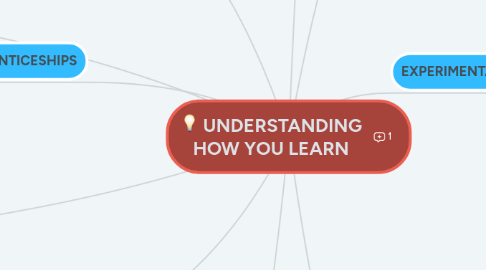
1. Scaffolding: provide framework to engage woth the task and keep right direction
2. The need of help and advice, aware of how others can help
3. REFLECTING - USING LEARNING JOURNALS
3.1. WHY KEEP A LEARNING JOURNALS?
3.1.1. Help to move around the learning circle
3.2. THOUGHTS ON THE LEARNINGJOURNAL FORMAT
3.2.1. Electronic versus Hand-wriiten
3.2.2. Critical incident versus diary
4. ALBERT BANDURA: CONFIDENCE AND SELF-EFFICACY
4.1. CONFIDENCE: General sense of self-belief
4.2. SELF-EFFICACY (4 SOURSES): persive ability to achieve given result
4.2.1. Mastery experience
4.2.2. Vacarious experience
4.2.3. Social persuation
4.2.4. Psysiological state
5. CORGNITIVE APPRENTICESHIPS
5.1. LEARNING FROM OTHERS
5.2. LEVELS OF LEARING
5.2.1. Fading: the support is faded gradually
5.2.2. Modelling: expert demonstrate
5.2.3. Coaching: observed by teacher/expert and given advice
5.2.4. Exploration: frame the problem itself and decide chich approach is the best
6. MENTORS
6.1. NEED FOR GUIDEANCE
6.2. BENEFIT FROM OBSERVATION OF SOMEONE WORK WITH
7. LEARNING TO LEARN
7.1. The most important skill to you over time
7.1.1. You can continue to learn long after present studies
7.2. Do in personal time and in personal place
7.3. PERSONAL DEVELOPMENT PLAN
7.3.1. Should be going on in schools and universities and in the world of works
8. IMPORTANCE OF REFLECTION
8.1. Think carefully about what you want to improve and achieve
8.2. Investigate and measure the current individual levels
8.3. Turn experience into practice
8.4. Recapture experience, think, mull over and evaluate it
8.5. Derive the fullest benefits from experiences
9. EXPERIMENTAL LEARNING
9.1. Concrete experience
9.1.1. Typical examples: field trips, training sessions, mistakes, reading, arguments, team discussions and so on
9.1.2. May be physical, feeling, thinking/emotional or a combination
9.1.3. Might happen, or might be observed affected in some ways
9.2. Reflection
9.2.1. Give own initial thoughts on what happned
9.3. Theorizing
9.3.1. Try to make sense of what happened
9.3.2. Think of other similar situations
9.3.3. Make and try to answer Wh-questions or Yes-No questions in order to understand clearly
9.4. Take into account initial observation from others
9.5. Testing
9.5.1. Test out ideas for improvement before applying them
9.5.2. Plan for next experience
10. HUMAN AND MUMFORD'S LEARNING STYLES
10.1. Activists
10.1.1. Think on their feet
10.1.2. Have short sessions, plenty of variety, the opportunity to initate
10.1.3. Participate and have fun
10.2. Reflectiors
10.2.1. Research and eveluate
10.2.2. Think before acting, thorough preperation
10.2.3. Make decisions in own time
10.2.4. Listen and observe
10.3. Theorists
10.3.1. Feel intellectualy stretched
10.3.2. Concepts and models
10.3.3. See the overall picture
10.3.4. Structure and clear objectives
10.3.5. A logical presentation observe
10.4. Pragamtists
10.4.1. See the relevance of their wor
10.4.2. Gain practical advantage from learning
10.4.3. Credible role models
10.4.4. Proven techniques
10.4.5. Activities to be real
